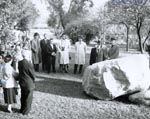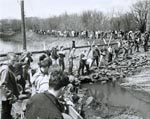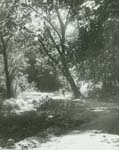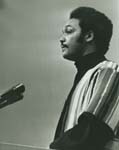Broadly speaking, Augustana students' responses to the major events of the 1960s reflected the political outlook of the school as a whole. In 1967 an editorial in the Observer noted that "last year the student body exhibited its general disapproval of demonstrations against the Vietnamese War, and only a small minority of Augie students have taken part in such demonstrations"; also in 1967, a poll of Augustana students and faculty demonstrated a near 50-50 split between those who supported and those who opposed the United States' policies in Vietnam. At the same time, however, students were taking greater and greater note of another significant issue: civil rights. In 1964 the student body made its first collective effort in support of the Civil Rights movement, raising money to donate to poor Southern African-Americans. By 1969, the newly-formed Afro-American Society organized a Black Power symposium, to which it invited some of the most controversial figures of the day. Students appeared at Centennial Hall en masse to learn about Black Power directly from those involved in the movement.
Even as the United States transformed in the 1960s, Augustana College as an institution witnessed changes of its own. In 1962 the Augustana Church, the formation of which had led directly to the establishment of the college and theological seminary in 1860, merged with three other bodies to form the Lutheran Church in America. And in the mid-1960s, the Lutheran School of Theology at Chicago, which formed in a merger of the Augustana Theological Seminary with three other seminaries, finally abandoned its Rock Island campus. Although the move permitted Augustana College to expand its grounds and science facilities, it also meant a final, symbolic break of the college and theological seminary, which had once been so closely tied to one another.
- 1960
- Augustana's 100th anniversary. A number of milestones fall during or near this centennial year, including the dedications of the College Union (Biology Building) and Centennial Hall, and the renaming of the Fine Arts Building after President Bergendoff. Other special events include a lecture by Nobel Laureate Glenn T. Seaborg and a performance in Centennial Hall by the Chicago Symphony Orchestra. Also in 1960, the Augustana Lutheran Church holds its centennial synod, for which the Handel Oratorio Society performs Haydn's The Creation. A significant topic of discussion at the synod is the possibility of a future merger of the Augustana Church with other Lutheran church bodies.
- June 1962
- Augustana Church merges with three other organizations-the American Evangelical Lutheran Church, the Finnish Evangelical Lutheran Church (Suomi Synod), and the United Lutheran Church in America-to form the Lutheran Church in America. In 1988, the Lutheran Church in America will merge with the American Lutheran Church and the Association of Evangelical Lutheran Churches to form the Evangelical Lutheran Church in America (ELCA), with which Augustana College remains affiliated to the present day.
- November 17, 1962
- Clarence Woodrow Sorensen inaugurated as 6th president of Augustana College. Sorensen holds a master's and a doctorate in geography from the University of Chicago; he is a respected scholar with extensive experience in international travel and study. Although Sorensen has past involvement with the Augustana Lutheran Church, he is the first layperson to be president of the college. He comes to Augustana from Illinois State University, Normal, where he was dean of the graduate school. He will serve as president for 13 years.
- February 26, 1964
- Augustana students hold "Fast for Freedom Food." The fast is part of a nationwide effort undertaken on this date by colleges and universities affiliated with the United States National Student Association. Four hundred sixteen Augustana students sign up to abstain from dinner for one evening; a monetary amount equivalent to the total value of the uneaten meals (before preparation) will provide food to low-income African-American farm workers in the South. President Sorensen praises this first significant campus effort in support of the civil rights movement, telling the Observer that the fast "gives the students a chance to DO something-rather than act as bystanders." The nationwide fast is so successful-with a total of over $10,000 raised by the participating schools-that another will be held on November 19, 1964.
- May 1964
- College approves Student Judiciary Committee. In its original form, the judiciary has seven student members. The Dean of Men and the Dean of Women act as advisers, determining which of the infractions reported to their offices should go before the judiciary, which hears testimony and decides on a penalty. The judiciary gives students greater authority in disciplinary matters on campus.
- April 26-29, 1965
- Augustana students fight Mississippi flood. The college cancels classes for four days as students and faculty join Quad Cities townspeople in sandbagging and help the Red Cross tend to families who have evacuated their homes. Rock Island mayor Morris E. Muhleman offers his official thanks for the students' efforts, which make national and international news. Cresting at 22.5 feet, seven feet over flood stage, the 1965 flood is the worst on record in the Quad Cities up to that time.
- February 13, 1966
- Campus church organized. The congregation has 103 charter members, including 12 students on a church council; it is the first all-student congregation in the Lutheran Church of America. Worship services are to be held at 9:30 and 11:00 on Sunday mornings.
- Fall 1966
- Erickson Hall opens to students. The new dormitory houses male students, who will live there but dine in Westerlin with their female classmates. Erickson Hall is named for Augustana's former Vice President and Treasurer, Knut Erickson.
- Slough path opens at the same time as Erickson Hall, to permit students to walk easily from the new dormitory to the main part of campus. Students first began clearing out the vegetation obstructing the slough in the early 1950s; they also constructed a seating area, which became known as the Augustana Memorial Amphitheatre, in honor of the Augustana students who had given their lives during times of war. Instrumental in building the amphitheatre was future Augustana chaplain Richard Swanson ('54), for whom the slough path will be renamed Swanie Slough Path in the early 2000s.
- June 2, 1967
- College completes purchase of theological seminary's property, as the latter has recently merged with three other seminaries to form the Lutheran School of Theology at Chicago (LSTC). Arrangements for the college to purchase the seminary's land and buildings began in the early 1960s, with the agreement that LSTC would continue using the Rock Island campus until the completion of its own Chicago campus in 1967. The new property will permit Augustana to expand its science facilities.
- June 30, 1967
- Augustana purchases North (now Sorensen) Hall from the Board of Publications of the Lutheran Church in America (LCA). North Hall had been the home of the Augustana Book Concern, the operations of which largely transferred to the Board of Publications after the formation of the LCA in 1962. As part of Augustana College, North Hall becomes home to numerous campus offices and, later, to academic departments and the Quad Cities Graduate Study Center as well. In 1974 the college's Board of Directors will rename the building Sorensen Hall, in honor of soon-to-retire President C. W. Sorensen.
- Fall 1968
- New Science Building (now Swenson Hall of Geosciences) opens. The New Science Building was formerly the theological seminary's library; in its transformed state, it houses the departments of Geology, Geography, and Physics. In 1992 the Board will rename the building after Carl E. Swenson of Rockford, in honor of his generous bequest to Augustana.
- February 7-8, 1969
- Black Power symposium organized by the students of Augustana's new Afro-American Society. Speakers include Dick Gregory, Andrew Hatcher, Roy Innis, Jesse Jackson, Roy Morrison, and C. S. Smith. Responses to the symposium-from alumni, parents, community members and others-range from approval at the college's willingness to address thorny issues to outrage at its choice to invite such controversial figures as Gregory and Adam Clayton Powell. (Ironically, Powell is unable to attend at the last minute because of a delayed flight.) Days before the symposium President Sorensen endorses it in a press release, emphasizing students' right to free inquiry and calling for civil, responsible behavior at the event. The symposium does run smoothly, and it attracts numerous college students and other attendees from outside the Augustana community.
- May 2, 1969
- John Deere Planetarium and Carl Gamble Observatory dedicated. The planetarium houses Moline businessman Carl Gamble's telescope and observatory, which Gamble bequeathed to Augustana in his will. The building as a whole is named in recognition of a donation from Deere and Company; it stands on property purchased from the theological seminary in 1967.
- Fall 1969
- Augustana adopts quarter system. The Educational Policies Committee first recommended a change from semesters to quarters in February 1968, arguing, according to the Observer, that quarters would be more in line with the "natural" calendar and would permit more "intense" and "profound" work on the part of students, as a result of their reduced load.




